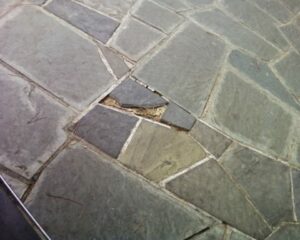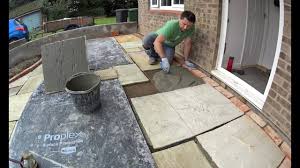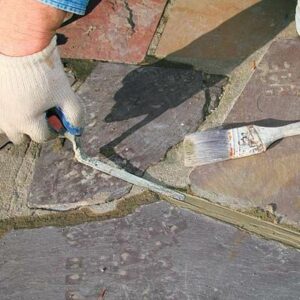I know if you own a flagstone patio, you have possibly encountered some loose stones a time or two. This repair is not really too hard to make. So let me show you how to repair flagstone patio loose stones.
Assess the problem
The first thing you will need to do is to determine just how much underlying damage there may be, to have caused the stone to come loose. You will need to remove the offending stone.
Remember to wear the appropriate safety gear at all times, eye, ear, gloves and dust  protection.
protection.
When a stone is very loose, and the surrounding joints are severely deteriorated, this repair can probably be accomplished with ease. Take your trowel, pry bar or screwdriver. Any tool that you can insert into the deteriorated joint area next to the stone. Push it down into the deteriorated joint and under the lower stone edge while prying upward. This should push the stone up, allowing you to remove it.
A loose stone that is surrounded by joints that are still in pretty good condition, will require you to remove some of the joint material in order to be able to pry the stone out. This can be accomplished with a 4″ angle grinder, fitted with a segmented or turbo diamond blade.
It is very handy to have a good quality wet-dry vac for this operation as it creates a lot of dust. With a helper holding the vac nozzle near the cutting blade, saw a kerf down into the joint right against the stone edge and also along the stone edge of any neighboring stones. Saw to a depth of 3/4″ to 1 ” for starters.
After performing the sawing operation. Take a chisel and small sledge hammer or drilling hammer and chisel out the surrounding joint material. I like to use a tuck point chisel for this operation as they will fit in tight spaces and remove small amounts of material at a time.
You may need to make more kerf cuts in wide joints that are difficult to remove. Every once in a while during the chiseling operation try inserting a pry bar or similar tool, as described before, to see if the stone can be pried up. Keep at it until you have removed the stone. Do not pry too hard on thin stones as you will risk breaking them.
Once you have the stone removed, take your wet- dry vac or a brush and remove all loose material from the removed stone area. It is very important to get the area beneath the removed stone as clean as possible. A loose stone where the area beneath the stone seems solid will be an easier repair. Once you are done removing the loose material, take a wire brush and give the whole area a good scrubbing. Vacuum the area again and determine the state that the base is in. When it does not scratch easy with metal tools and shows the impression of the bottom of the removed stone, follow the instructions for the thin set repair.
A repair where the surface beneath the removed stone still seems dusty, loose and easily penetrated by metal tools, will require you to remove all the loose material until you reach solid material. Keep removing the loose material until you reach something solid ,as described before, or all cement base is removed. Follow the directions for the thick set repair.
Thin Set Repair
With clean water and a stiff brush clean the area beneath the stone that you have prepared from the previous steps. Get the area as clean as you possibly can as this will insure that you get good adhesion with your mortar. Dry the area thoroughly using sponges and air from the exhaust of the wet- dry vac. Clean the bottom of the stone similarly.
For the repair mortar you can either use an exterior thin set mortar or straight portland cement mixed with water. The consistency should be similar to peanut butter. Lightly dampen the bottom of the stone and its prepared base. There should not be any more water present then to cause a darkening of the prepared areas.
Apply the mortar to the prepared base. Apply mortar to the bottom of the stone, forcing it into the surface by applying heavy pressure with your trowel and removing most of the applied mortar too. This will insure good adhesion to the stone which is where most separation usually occurs.
Set the stone in place and lightly seat it with a rubber mallet causing some of the mortar to squeeze out into the joints. Seat the stone until you are satisfied that it is even with the surrounding stones. It will be a little higher in this repair but it should be pretty close. Trowel down and remove excess mortar from the joints, you will finish the joints with a different mortar as described below.
Thick Set Repair
Keep removing the deteriorated loose material until you get to a surface solid enough to make an acceptable repair. This will be as described before. It should not scratch easily or flake off with metal tools. Once you have got to an acceptable surface, clean this area with clean water and a stiff brush very thoroughly. This is very important. It may be that you removed all of the cement base below the stone. When that is the case you of course can skip the cleaning step. Clean the bottom of the stone with the stiff brush and clean water also regardless.
When there is still some cement base present and you have finished cleaning it, dry the area thoroughly with sponges and air from the exhaust of your wet-dry vac.
Lightly dampen the prepared base and stone with clean water. There should be no more water present than to darken the surfaces that it was applied to. Mix your base mortar. This can be a pre-mixed sand mix from your store or you can make your own mortar with mason sand and portland cement. When you make your own mortar, mix 2 parts sand to 1 part portland cement. A small splash of acrylic admix is helpful during the mixing process if it is available.
Mix the cement to a consistency that is firm and not too runny. Peanut butter is usually used as a description of the desired consistency or texture. Just be sure to not use too much water. Add a little at a time. Place your mortar on the prepared base allowing enough room for the thickness of the stone. Apply mortar to the bottom of the stone with a heavy, scraping pressure removing most of it but leaving a thin layer. This will aid in insuring a good bond to the stone.
Lightly tap the stone into place with a rubber mallet. Mortar should squeeze into the joints from beneath the stone. Continue seating the stone until you are satisfied it is even with the surrounding stones.
Finish The Joints
Once you are satisfied that your stone is seated properly from either of the previous two steps it is time to finish the joints surrounding the stone. Using either the sand mix from the store or the home made mix I described for the thick set repair, tool the mortar into the joints surrounding the stone. I usually like to wait until the mortar from setting the stones has firmed up a bit and no water is present in the joint.
Smooth the joints off even with the surrounding stone. Once the joints have set to a firm thumbprint texture, you can finish them with a soft bristled mason brush or paint brush. Clean the surface of the stones with damp rags if necessary.
Take a look at the following video which explains the process similarly to what I have described:
You can check out this repair mortar by clicking here.
I hope you have found this post helpful. Please leave any comment or questions below.
